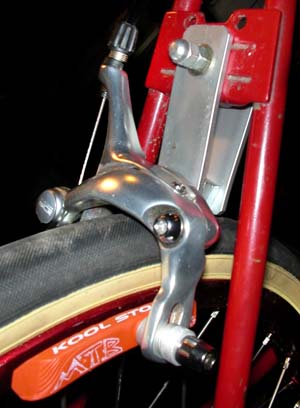Selbstbau "Drop Bolts": Unterschied zwischen den Versionen
(Übersetzungsanfang) |
(→Elegant? Nein. Praktisch? Ja.: übersetzt) |
||
| Zeile 28: | Zeile 28: | ||
John Allen has another example. He placed the drop bolt entirely behind the flat Pletscher plate of his Twenty, so the fender could be mounted to the tab at the bottom of the plate. | John Allen has another example. He placed the drop bolt entirely behind the flat Pletscher plate of his Twenty, so the fender could be mounted to the tab at the bottom of the plate. | ||
==Elegant? Nein. Praktisch? Ja.== | ==Elegant? Nein. Praktisch? Ja.== | ||
Dieses System schaut ein wenig lustig aus, funktioniert jedoch absolut einwandfrei. [[Sheldon Brown]] hat es nie bei einem Kundenfahrrad zum Einsatz gebracht, jedoch mehrere seiner persönlichen Fahrräder hat er selbst auf diese Weise ausgestattet. | |||
==Quelle== | ==Quelle== | ||
Version vom 11. Juli 2018, 06:56 Uhr
Ein "Drop Bolt" ist eine spezielle Vorrichtung, mit der man den zentralen Gewindebolzen einer Zangenbresmse versetzt montieren kann, damit dieser weiter nach unten vom eigentlichen Montageloch entfernt ist und die Bremse so weiter abwärts greifen kann. Man benötigt diesen "Drop Bolts" für gewöhnluich, wenn man ein Fahrrad mit kleineren Laufrädern austattet als vorgesehen. Am häufigsten kommen sie zum Einsatz wenn man 27 Zoll (630 mm) Reifen gegen 28 Zoll (700C) Laufräder tauscht.
- Siehe auch
- Reifengrößen - für den Fall, dass sich jemand wundert, dass 27 Zoll Reigen größer sind als 28 Zoll Reifen.
Welche Drop Bolts gibt es für welche Bremse?
Drop Bolts waren hauptsächlich für Eingelenk-Seitenzugbremsen verfügbar, die zwei Muttern hatte, um die Bermsarme mit dem Gewindebolzen zu verbinden. Unglücklicherweise sind diese Bremsentypen inzwischen fast ausgestorben.
Drop Bolts gibt es nicht für Eingelenk-Seitenzugbremsen, deren Gewindebolzen fest mit der Bremse verbunden ist. das gilt zum beispiel für alle Shimano Modelle.
Drop Bolts gab es auch für Zweigelenk-Seitenzugbremsen. Inzwischen sind diese nicht mehr verfügbar.
Selbstbaulösung
I have made home-made drop bolt replacements from aluminum stock or even reflector brackets. For example, a reflector bracket has two holes for the reflector. Cut off the flat part the reflector mounts to, with its two holes. You need two of these, one in front of the fork crown/seatstay bridge, the other behind it.
One set of holes is secured to the brake bridge/fork crown with a 6 mm or 1/4" bolt. The center bolt of the caliper goes through the other set of holes, with a stack of washers between the flat pieces of reflector bracket. You may have a problem if the center bolt isn't long enough.
A more elegant variation on this is to use aluminum stock from the hardware store. I usually use 3/4" x 1/8" stock. Space the holes so that the brake shoes wind up near the top of their adjusting slots, this gives better braking.
To the right you can see the rig on one of my Raleigh Twentys, using a short (39-49 mm) reach Shimano caliper on a bike that originally needed a 100 mm reach caliper.
I used some oversized square nuts I had hanging around as spacer washers. The caliper I used was intended for "recessed" front mounting, and the center bolt wasn't as long as I would have liked, so the front and back aluminum strips are not parallel, but this is still sturdy enough, and gives super braking.
John Allen has another example. He placed the drop bolt entirely behind the flat Pletscher plate of his Twenty, so the fender could be mounted to the tab at the bottom of the plate.
Elegant? Nein. Praktisch? Ja.
Dieses System schaut ein wenig lustig aus, funktioniert jedoch absolut einwandfrei. Sheldon Brown hat es nie bei einem Kundenfahrrad zum Einsatz gebracht, jedoch mehrere seiner persönlichen Fahrräder hat er selbst auf diese Weise ausgestattet.
Quelle
Dieser Artikel basiert auf dem Artikel Home Made "Drop Bolts" von der Website Sheldon Browns. Originalautor des Artikels ist Sheldon Brown.
- Sattelstützenmaße
- Knarzen, Knacken und Quietschen
- Ritzelabstände (Tabelle)
- Auswechselbarkeit von Vierkant-Kurbelaufnahmesystemen bei Innenlagern
- Kettenlinienstandards (Tabelle)
- Ein bequemer Sattel
- Nabenbreiten (Tabelle)
- Alles über Nabenschaltungen
- Shimano Nexus und Alfine Acht-Gang-Naben
- Reifengrößen
